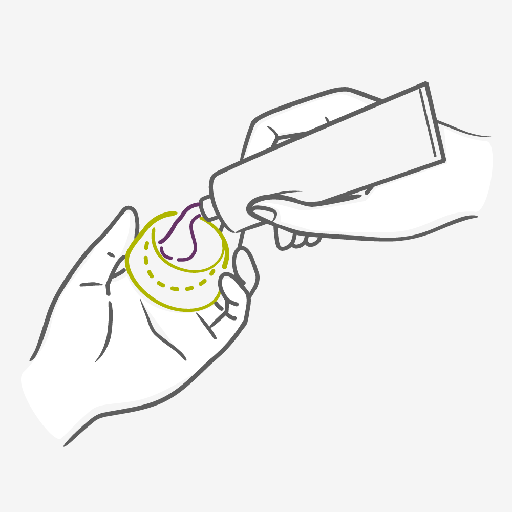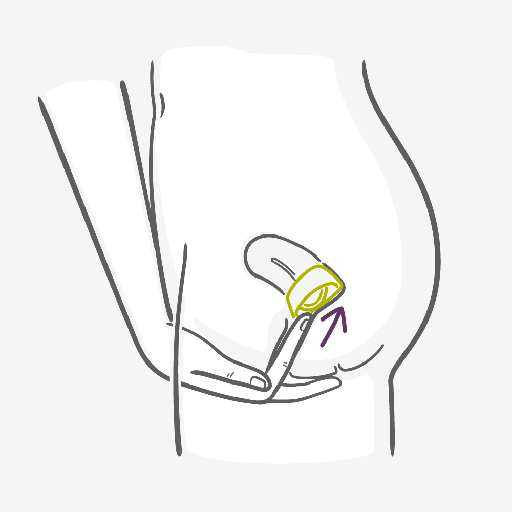CERVICAL CAP
WHEN and HOW?
You must put the cap in the vagina before you have sex and this might feel a little tricky at first but practice, as always, makes you more familiar with the process. The cervical cap has an efficacy of 84% with typical use.
How to use the cervical cap?
The cap should not be used alone though, to keep yourself properly protected the cap should always be used with spermicides.
The cervical cap comes in different size, ranging from 22 to 26 mm. A pelvic examination by your doctor or healthcare provider will determine which size you need based on your obstetrical history. Get more information here
Tabs header
CERVICAL CAP PROS:
- It can be used on demand
- They are easily carried with you
- It isn’t affected by other medications
- It can be used when breastfeeding
- Hormone free
- Low cost
CERVICAL CAP CONS:
- It can interfere with sexual spontaneity
- Using it can take practice
- It requires keeping track of the hours inserted
- Not always suitable for women who have given birth
- Requires initial fitting by healthcare provider
- Effectiveness increases when used in combination with spermicides
- Low efficacy even when used as directed
- The cap may cause irritation or allergic reactions
- If you keep it in place longer than 48 hours, there is a risk of toxic shock syndrome. Toxic shock is a rare but serious infection
- Does not protect against HIV infection (AIDS) and other sexually transmitted infections (STIs)
All important details about the Cervical Cap
The cervical cap is only really a cap in the way it looks, if you have an imagination. In reality, the way the cervical cap works is much more like a plug, it is pushed up into the vagina until it covers the cervix so no sperm can enter the uterus. The cap is made of soft latex or silicone with a round rim, which is smaller than the diaphragm and only covers the cervix.
The cervical cap comes in different size, ranging from 22 to 26 mm. A pelvic examination by your doctor or healthcare provider will determine which size you need based on your obstetrical history e.g. women who never have been pregnant will use a smaller size than women who have had delivered a baby. Smaller or larger sizes are then inserted until the correct fit is achieved. It should fit snugly into the upper half of the vagina. The woman should practice insertion under supervision and placement should be inspected to ensure that the fitting ring is correctly positioned in the vagina. The cervical cap may require resizing following a full-term pregnancy, pelvic surgery, or abortion, or if there is a major change in weight. It is recommended that the cervical cap gets replaced every year or even sooner if it shows any signs of deterioration.
The cap should not be used alone though, to keep yourself properly protected the cap should always be used with spermicides.

Questions & Answers about the Cervical Cap
FREQUENTLY ASKED QUESTIONS
Most spermicides have an unpleasant taste but will not usually harm you or make you feel ill, however it is advisable to avoid swallowing excessive amounts. If you are concerned about feeling ill following swallowing some spermicide, you should seek the advice of a healthcare provider.
Spermicides contain substances that kill sperm. Some products also form a thick foam or mucus which blocks the cervix and acts as a barrier against the sperm. They can come in the form of foam, foaming tablets, pessaries, creams, jellies and sponges. Spermicides are not effective enough when used alone, and should be used in combination with barrier methods such as the diaphragm or cap.
No, the cervical cap cannot be used during menstruation, as it would impede the natural flow of menstrual bleeding. To be protected against unintended pregancies during that period in time, you must use another contraceptive method, such as condoms, until your menstruation is finished.
The cervical cap comes in different size, ranging from 22 to 26 mm. A pelvic examination by your doctor or healthcare provider will determine which size you need based on your obstetrical history e.g. women who never have been pregnant will use a smaller size than women who have had delivered a baby. Smaller or larger sizes are then inserted until the correct fit is achieved. It should fit snugly into the upper half of the vagina. The woman should practice insertion under supervision and placement should be inspected to ensure that the fitting ring is correctly positioned in the vagina. The cervical cap may require resizing following a full-term pregnancy, pelvic surgery, or abortion, or if there is a major change in weight. It is recommended that the cervical cap gets replaced every year or even sooner if it shows any signs of deterioration.
There is no reason for the cervical cap to get lost or stuck inside your body. It will be specifically fitted by a healthcare provider to ensure it fits and can be used effectively by you. The cervical cap should also be checked frequently by a healthcare provider to make sure it still fits properly.
FREQUENTLY ASKED QUESTIONS
Most spermicides have an unpleasant taste but will not usually harm you or make you feel ill, however it is advisable to avoid swallowing excessive amounts. If you are concerned about feeling ill following swallowing some spermicide, you should seek the advice of a healthcare provider.
You cannot see any change in the patch, or feel it working, but it is continuously releasing the hormones estrogen and progestin into the bloodstream. You just need to ensure you change the patch each week for three weeks, and remember to start the next cycle of patches after the fourth patch free week.
No, the cervical cap cannot be used during menstruation, as it would impede the natural flow of menstrual bleeding. To be protected against unintended pregancies during that period in time, you must use another contraceptive method, such as condoms, until your menstruation is finished.
The cervical cap comes in different size, ranging from 22 to 26 mm. A pelvic examination by your doctor or healthcare provider will determine which size you need based on your obstetrical history e.g. women who never have been pregnant will use a smaller size than women who have had delivered a baby. Smaller or larger sizes are then inserted until the correct fit is achieved. It should fit snugly into the upper half of the vagina. The woman should practice insertion under supervision and placement should be inspected to ensure that the fitting ring is correctly positioned in the vagina. The cervical cap may require resizing following a full-term pregnancy, pelvic surgery, or abortion, or if there is a major change in weight. It is recommended that the cervical cap gets replaced every year or even sooner if it shows any signs of deterioration.
There is no reason for the cervical cap to get lost or stuck inside your body. It will be specifically fitted by a healthcare provider to ensure it fits and can be used effectively by you. The cervical cap should also be checked frequently by a healthcare provider to make sure it still fits properly.




































